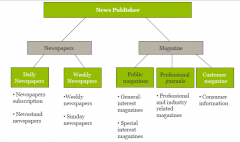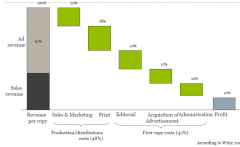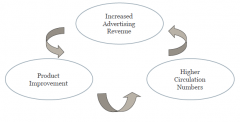- Barajar
ActivarDesactivar
- Alphabetizar
ActivarDesactivar
- Frente Primero
ActivarDesactivar
- Ambos lados
ActivarDesactivar
- Leer
ActivarDesactivar
Leyendo...
Cómo estudiar sus tarjetas
Teclas de Derecha/Izquierda: Navegar entre tarjetas.tecla derechatecla izquierda
Teclas Arriba/Abajo: Colvea la carta entre frente y dorso.tecla abajotecla arriba
Tecla H: Muestra pista (3er lado).tecla h
Tecla N: Lea el texto en voz.tecla n
![]()
Boton play
![]()
Boton play
![]()
20 Cartas en este set
- Frente
- Atrás
- 3er lado (pista)
|
Newspaper
Magazine |
Origin in 1605: Weekly bulletin
Las third of 17th century |
"
|
|
Definition Newspaper
|
Newspapers are periodical publications, which serve as continuous up-to-date means of communications. They usually include issues of politics, economics, current events, culture, entertainment as well as sports, and appear at least twice a week.
|
Periodical publications, up-to-date, many topics, at least twice a week
|
|
Market
|
Actuality = timelessness
Publicity = accessibility Universality = open to all areas of life Frequency = regular appearance |
"
|
|
Types of Newspapers
|
Dailies
Weeklies |
|
|
By selling
|
Newsstand or popular newspaper
Subscriber newspaper |
|
|
By content and range
|
Local (high level reader-paper-bonding)
Regional Nationwide (direct competition) |
|
|
By frequency
|
Daily
Sunday Weekly |
|
|
By price
|
Free offers (advertising, free papers)
Chargeable offers |
|
|
Some Facts
|
-Declining market, 8% a year.
-Circulation: Most circualtion in Norway and Japan (612), followed by Germany (289). -Germany 20% less circulation sold, but some national newspaper ok |
-Circulation
-Declining worldwide -Germany |
|
Definition Magazine
|
Magazines are periodical print publications, which appear continuously, without a time limit, at least four times a year.
|
|
|
Types of magazines
|
Public/Popular magazines:
-Wide range topics -Frequent Professional/Speacialist journals: -Tematic focused, professional -Released in unlimited period |
Public/popular
Professional/Specialist |
|
News publisher categorization (map)
|

|
|
|
Value of chain
|

|
|
|
Costs and revenue structure
|

|
|
|
Market Entry Barriers
|
Economies of scale
Advertising-circulation-spiral Sunk costs Economies of scope |
|
|
Advertising circulation spiral
|

|
|
|
Types of concentration
|
Economic: Determined by the publisher's share of circulation. Suppliers that have subsantial part of the market.
Journalistic: Measured by the the number of independent editorial offices in a specific area |
Economic and journalistic concentration
|
|
Theoretical explanations for newspapers failures
|
1. Cannibalization
2. Satisficer: happy with 2nd best choice 3. Generation z: digital natives not print 4. Disruptive technology: print "boring" 5. Solution: No magic bullet solution 6. Adv.circulation spiral: less readers, -adv |
|
|
BUT
|
New media do no replace old ones, proceeds cumulative, not substitution. They remain side by side, Wolfgan Riepl.
|
|
|
What to do?
|
1. Multiple platforms
2. Change format and content in print 3. Journalism 2.0 4. Engage and comm. With readers 5. Cross-media advertising concepts 6. Open newsroom and reorganize 7. Engage young readers 8. Improve product and serv. Quality 9. Explore multiple business model 10. Branding and raise reader aff. |